Just one more thing...
We thought that the following might serve as a fitting conclusion to our Peru blog. I was asked to write a short article about our time with Baptist Missions staff in Peru for Irish Baptist Life magazine, and it serves as a pencil sketch of our wonderful time with these folks in the summer. Now this is definitely the last post...
Trying to get a good picture can be a tricky business in Peru. Its not that the light is bad, or that there aren’t plenty of photogenic people and places. It is simply difficult to get a snapshot of the essence of the country, of what makes the culture and the people tick. There are endless options and opportunities: whether the almost lunar landscape of the sierra, the enchantment of condors circling effortlessly on early morning currents at Colca Canyon, the wildness of the mountains around Macchu Picchu yielding to man made terrace and uniformity, or the bright shock of traditional colours and costumes worn by the people themselves. All of these pictures reveal a country steeped in history and open for tourism - but they also conceal other less pleasant scenes. The picture of a man in Arequipa salvaging breakfast from bin bags before the dogs come for their share; the picture of children on the streets of Lima selling goods and performing music or juggling for money at traffic lights; the image of affluence and destitution living as uneasy neighbours in the same city and district. All of these are images we have carried away from our six week sabbatical trip in Peru, each equally vivid and moving in their own way.
Similarly it is difficult to present one picture of God’s work as it is carried on by and among Peruvian people. There are bright spiritual landscapes verdant with the blessing of God, and there are hard and barren places where faithfulness and visible fruit are in no way proportionate. So how can we sum up our time in Peru, what can we use as a snapshot of what we saw and what we learned during our time away? Three pictures will provide a small ‘album’ of our experience, and hopefully stimulate prayer among God’s people for their Peruvian brothers and sisters, and our own missionaries serving among them.
The first image is of people weeping. These are not tears of joy, nor of personal sorrow, but of a community of God’s people gripped by the reality of the faith they profess. The location is Peschay in Tacna, and it is Sunday morning. There has been a full programme in place on this particular day. The assistant Pastor Ramon has preached a stirring message on baptism, following which we have witnessed married couple Pedro and Rosanna publicly testify to their faith in Christ through baptism, in the outdoor tank. Now we stand in a circle outside the church building. We are about to break bread together, and Pedro and Rosanna are going to be welcomed into membership. But before these happy events there must be tears - it is time to reflect on the importance of remembering the Lord. John and Lourdes Brew live among these people, loving them deeply, and serving God faithfully. They explain that this time is known as the ‘general pardon’ where each believer speaks to his or her brother or sister and seeks forgiveness for any offence they may have caused to them. The process takes about forty five minutes, the believers moving around the circle systematically, some with smiles, many with tears – preparing their hearts to remember the Lord, making sure that their worship isn’t mingled with the poison of spite. This is a good image for us to hold in our minds, because it portrays for us something of the simplicity and sincerity of many Peruvians’ faith. These are weak and vulnerable believers just like you and I, subject to the same pitfalls and temptations as we are – but their earnestness and devotion is simultaneously thrilling and heartbreaking.
The second image is of a building site. Compared to the sweeping grandeur of Macchu Picchu or the sun-baked colonial buildings of ‘old’ Lima, it may not look picturesque. But this is a landscape charged with importance and potential. We are now standing on the soil of the Ite Camp and Conference Centre, as Trevor Morrow guides us around the site, showing us the features that are nearing completion, and the areas which are awaiting construction. Whether it is the hard-court games area, the fronton wall (a form of outdoor squash), the well finished accommodation blocks, or the amphitheatre with its seashell ground covering, the visitor can almost hear the clamour of children’s voices which will soon fill this place. Trevor’s excitement is palpable as he explains the vision behind the centre, the aspirations that the board of Trustees have for its use among children’s and disabled groups in coming days, as well as for church retreats. Just over the hill is the village of Ite where Baptist Missions are labouring to spread the gospel. It is not an easy area to work into, with discouragements as well as encouragements, but Trevor and Christine, along with Milagros Tipiani (one of the Peruvian national workers, much prayed for in Ireland) have won respect by the way in which they have conducted their evangelism. Milagros has moved away from family to live in the village among the people, and the residents of Ite can have no doubts that the mission staff care about them and are interested in investing time in the village. One of the evidences they can cite is the aerial picture they get of the camp and conference centre each time they travel down the mountain to the sea. It is Trevor and Christine’s prayer that God will breathe life into this site nestled in the valley, and use it for the glory of His name and extension of His kingdom.
The third picture is of a vacant space on a rooftop. It is not the kind of picture that you would enlarge and place on your wall as a central feature, but this picture is deceptive in its simplicity. If you look at the image for a long enough period you can trace the outline of where a radio transmitter will rest in the near future. You can look beyond this rooftop and make out in faint relief the many other roofs of homes across Tacna where Christ isn’t known. This vacant space will soon be of vital importance to the people of the town – even if they don’t know about it yet. We are, of course, standing on the roof of the radio station, located in Cono Sur, Tacna. Ken Scott is sharing about some of the victories and disappointments they have faced as they labour to secure a license and get Christian programming onto the airwaves. The radio station building is well furnished and, at the moment, sparsely populated, but again its influence will spread far and wide in God’s time. Christian music is being bought up, as are the rights to a varied audio ministry schedule, and Ken and Jeannie Scott along with national worker Blanca Valenzuela are waiting and working for the day when its sound spreads out across the locality.
These are simply snapshots, and only make up a tiny proportion of the images our minds have captured during our six week trip to Peru. We could show you other pictures which are bold and bright with the blessing of God, and still others which are poorly lit showing the difficulties and weaknesses of the Peruvian church. But through all of these individual pictures one overwhelming image emerges – God is at work, using His people in His way for His glory. In the month before we left for Peru the Association assembly meetings carried the theme of ‘A Work in Progress’. This is the label which we place on the front of our album of images and impressions from Peru. Only eternity will show us the full picture of what God has done through His workers in this generation, the generation which has passed, and those which may yet come before Christ returns.
Trying to get a good picture can be a tricky business in Peru. Its not that the light is bad, or that there aren’t plenty of photogenic people and places. It is simply difficult to get a snapshot of the essence of the country, of what makes the culture and the people tick. There are endless options and opportunities: whether the almost lunar landscape of the sierra, the enchantment of condors circling effortlessly on early morning currents at Colca Canyon, the wildness of the mountains around Macchu Picchu yielding to man made terrace and uniformity, or the bright shock of traditional colours and costumes worn by the people themselves. All of these pictures reveal a country steeped in history and open for tourism - but they also conceal other less pleasant scenes. The picture of a man in Arequipa salvaging breakfast from bin bags before the dogs come for their share; the picture of children on the streets of Lima selling goods and performing music or juggling for money at traffic lights; the image of affluence and destitution living as uneasy neighbours in the same city and district. All of these are images we have carried away from our six week sabbatical trip in Peru, each equally vivid and moving in their own way.
Similarly it is difficult to present one picture of God’s work as it is carried on by and among Peruvian people. There are bright spiritual landscapes verdant with the blessing of God, and there are hard and barren places where faithfulness and visible fruit are in no way proportionate. So how can we sum up our time in Peru, what can we use as a snapshot of what we saw and what we learned during our time away? Three pictures will provide a small ‘album’ of our experience, and hopefully stimulate prayer among God’s people for their Peruvian brothers and sisters, and our own missionaries serving among them.
The first image is of people weeping. These are not tears of joy, nor of personal sorrow, but of a community of God’s people gripped by the reality of the faith they profess. The location is Peschay in Tacna, and it is Sunday morning. There has been a full programme in place on this particular day. The assistant Pastor Ramon has preached a stirring message on baptism, following which we have witnessed married couple Pedro and Rosanna publicly testify to their faith in Christ through baptism, in the outdoor tank. Now we stand in a circle outside the church building. We are about to break bread together, and Pedro and Rosanna are going to be welcomed into membership. But before these happy events there must be tears - it is time to reflect on the importance of remembering the Lord. John and Lourdes Brew live among these people, loving them deeply, and serving God faithfully. They explain that this time is known as the ‘general pardon’ where each believer speaks to his or her brother or sister and seeks forgiveness for any offence they may have caused to them. The process takes about forty five minutes, the believers moving around the circle systematically, some with smiles, many with tears – preparing their hearts to remember the Lord, making sure that their worship isn’t mingled with the poison of spite. This is a good image for us to hold in our minds, because it portrays for us something of the simplicity and sincerity of many Peruvians’ faith. These are weak and vulnerable believers just like you and I, subject to the same pitfalls and temptations as we are – but their earnestness and devotion is simultaneously thrilling and heartbreaking.
The second image is of a building site. Compared to the sweeping grandeur of Macchu Picchu or the sun-baked colonial buildings of ‘old’ Lima, it may not look picturesque. But this is a landscape charged with importance and potential. We are now standing on the soil of the Ite Camp and Conference Centre, as Trevor Morrow guides us around the site, showing us the features that are nearing completion, and the areas which are awaiting construction. Whether it is the hard-court games area, the fronton wall (a form of outdoor squash), the well finished accommodation blocks, or the amphitheatre with its seashell ground covering, the visitor can almost hear the clamour of children’s voices which will soon fill this place. Trevor’s excitement is palpable as he explains the vision behind the centre, the aspirations that the board of Trustees have for its use among children’s and disabled groups in coming days, as well as for church retreats. Just over the hill is the village of Ite where Baptist Missions are labouring to spread the gospel. It is not an easy area to work into, with discouragements as well as encouragements, but Trevor and Christine, along with Milagros Tipiani (one of the Peruvian national workers, much prayed for in Ireland) have won respect by the way in which they have conducted their evangelism. Milagros has moved away from family to live in the village among the people, and the residents of Ite can have no doubts that the mission staff care about them and are interested in investing time in the village. One of the evidences they can cite is the aerial picture they get of the camp and conference centre each time they travel down the mountain to the sea. It is Trevor and Christine’s prayer that God will breathe life into this site nestled in the valley, and use it for the glory of His name and extension of His kingdom.
The third picture is of a vacant space on a rooftop. It is not the kind of picture that you would enlarge and place on your wall as a central feature, but this picture is deceptive in its simplicity. If you look at the image for a long enough period you can trace the outline of where a radio transmitter will rest in the near future. You can look beyond this rooftop and make out in faint relief the many other roofs of homes across Tacna where Christ isn’t known. This vacant space will soon be of vital importance to the people of the town – even if they don’t know about it yet. We are, of course, standing on the roof of the radio station, located in Cono Sur, Tacna. Ken Scott is sharing about some of the victories and disappointments they have faced as they labour to secure a license and get Christian programming onto the airwaves. The radio station building is well furnished and, at the moment, sparsely populated, but again its influence will spread far and wide in God’s time. Christian music is being bought up, as are the rights to a varied audio ministry schedule, and Ken and Jeannie Scott along with national worker Blanca Valenzuela are waiting and working for the day when its sound spreads out across the locality.
These are simply snapshots, and only make up a tiny proportion of the images our minds have captured during our six week trip to Peru. We could show you other pictures which are bold and bright with the blessing of God, and still others which are poorly lit showing the difficulties and weaknesses of the Peruvian church. But through all of these individual pictures one overwhelming image emerges – God is at work, using His people in His way for His glory. In the month before we left for Peru the Association assembly meetings carried the theme of ‘A Work in Progress’. This is the label which we place on the front of our album of images and impressions from Peru. Only eternity will show us the full picture of what God has done through His workers in this generation, the generation which has passed, and those which may yet come before Christ returns.

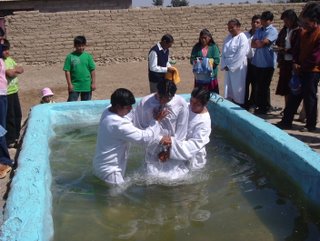
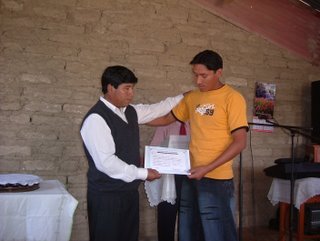
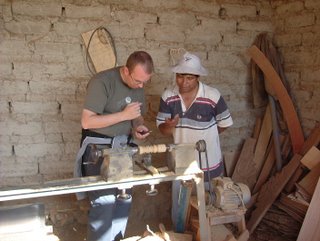

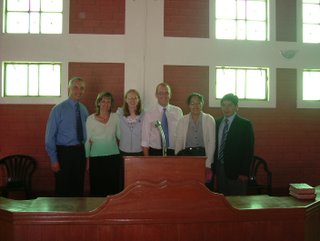
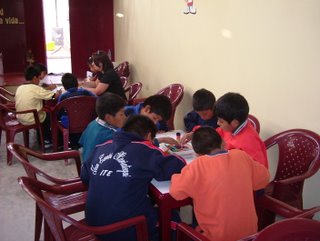
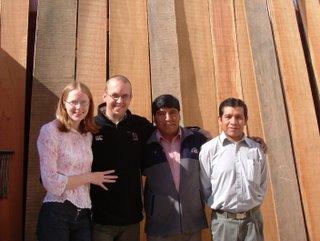



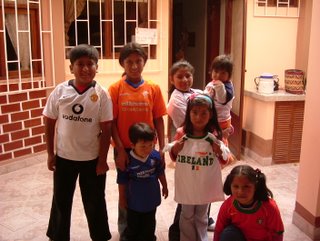 Tomorrow we hope to travel down to Ilo to spend five days with Trevor and Christine. It will be great to renew fellowship with them as a family, to see the work in La Pampa again, and to be introduced to the work in Ite - particularly the camp and conference centre. We'd value your prayers as it will be quite a busy time with two speaking engagements on Sunday, and one on Tuesday night. Thanks again for all of your support and contact. We're upholding you all at home in prayer as well.
Tomorrow we hope to travel down to Ilo to spend five days with Trevor and Christine. It will be great to renew fellowship with them as a family, to see the work in La Pampa again, and to be introduced to the work in Ite - particularly the camp and conference centre. We'd value your prayers as it will be quite a busy time with two speaking engagements on Sunday, and one on Tuesday night. Thanks again for all of your support and contact. We're upholding you all at home in prayer as well.






